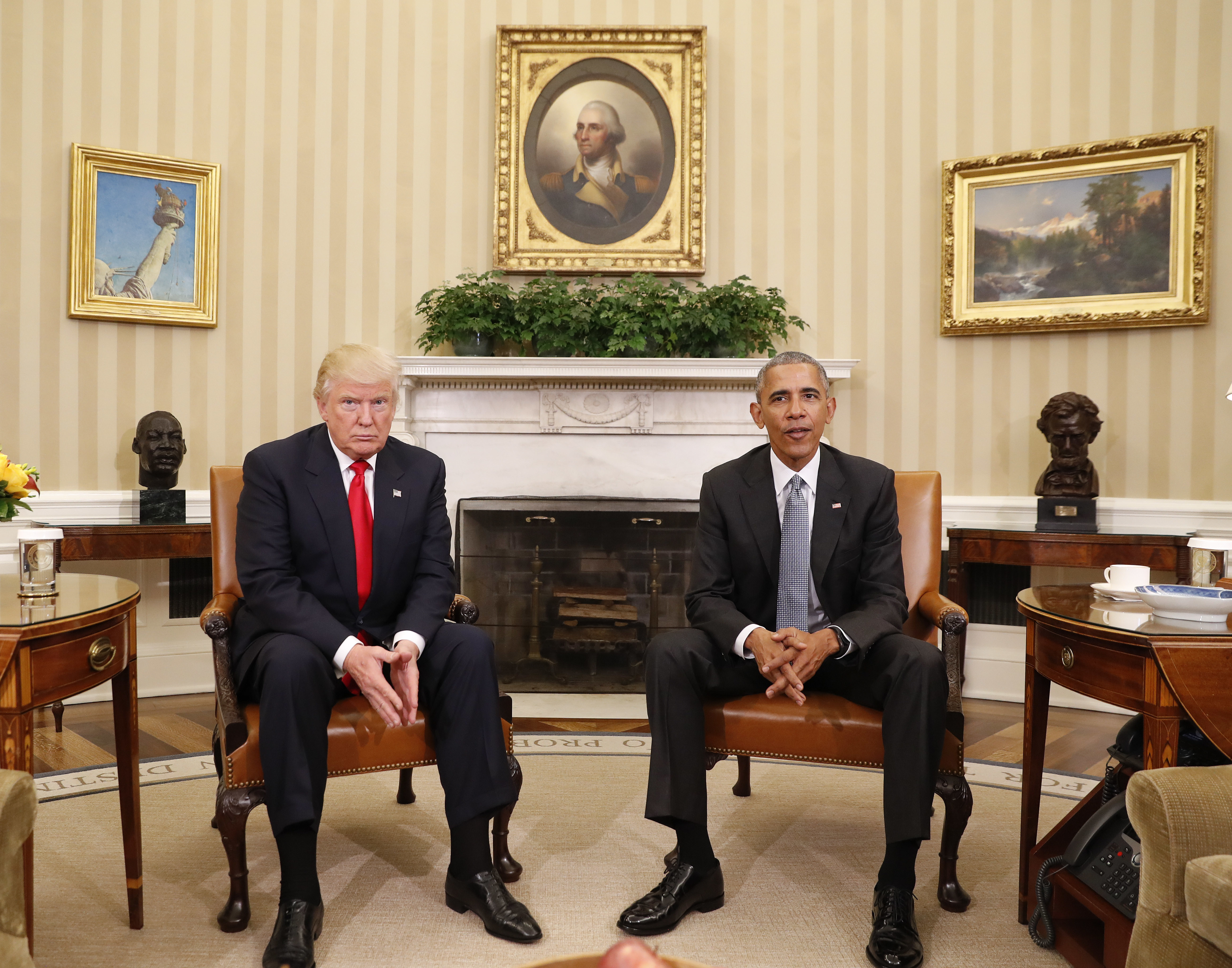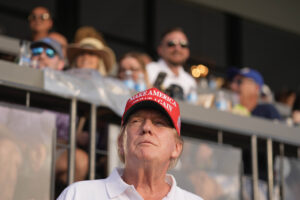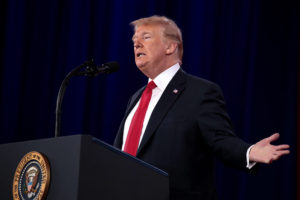The United States of Free Speech, Violence and Hypocrisy
Pretexts and posturing run throughout the public discourse, dominated by partisan apparatchiks around both Trump and the Democrats. President-elect Donald Trump and then-President Barack Obama in the Oval Office shortly after the 2016 election. (Pablo Martinez Monsivais / AP)
President-elect Donald Trump and then-President Barack Obama in the Oval Office shortly after the 2016 election. (Pablo Martinez Monsivais / AP)
This article was first published on Sam Husseini’s website Friday.
Many have focused on President Donald Trump’s statements on Charlottesville condemning the “violence” from “both sides.” Which is understandable, since the killing of Heather Heyer and overwhelming violence came from white supremacists. But virtually no one has scrutinized the first half of his remarks: Trump criticizing the “violence” of others.
How is it that Trump is designated to be in a position of judging the perpetrators of violence? The U.S. government is regularly bombing a number of countries. Just last week, Trump threatened North Korea with nuclear destruction in unusually blunt language—”fire and fury”—rather than the typical Obama administration’s veiled nuclear attack code lingo “all options are on the table.”
On Monday, the same day Trump read a scripted condemnation of white supremacist violence, Airwars.org reported that in Syria: “Marwa, Mariam and Ahmad Mazen died with their mother and 19 other civilians in a likely Coalition strike at Raqqa.”
You’d be hard pressed to find a “news” story about them. That’s the concern with the effects of “violence” when it emanates from the U.S. government.
But the threats and use of violence are not new, nor is the hypocrisy. As President Bill Clinton was ordering the ongoing bombing of Yugoslavia in 1999, he took time out of his schedule to address the shooting at Columbine High School: “We must do more to reach out to our children and teach them to express their anger and to resolve their conflicts with words, not weapons.”
Such outbreaks of domestic political violence are used not as openings for introspection about longstanding violence in U.S. society, but for rallying cries to uphold alleged virtues of the nation. The recent attacks are “repugnant to everything we hold dear as Americans,” Trump claims.
That’s because we live “under law and under the Constitution … responding to hate with love, division with unity, and violence with an unwavering resolve for justice. No matter the color of our skin, we all live under the same laws, we all salute the same great flag, and we are all made by the same almighty God.”
The words Trump uttered seemed to echo Saint Augustine. Charles Avila in “Ownership: Early Christian Teaching,” outlines Augustine’s beliefs: “The Creator, who alone is Absolute Owner, did not make us human beings so many ‘islands,’ without any relation to each other, but one human family, ‘made from one mud’ and sustained ‘on one earth.’ … We enjoy the same natural conditions: ‘born under one law, living by one light, breathing one air and dying one death.’ “
Thus, what seemingly originated as a universal theological admonition—to attack the notion of private property no less—has been perverted into a narrow nationalist one with universalist trappings. It simultaneously seems to condemn violence while actually facilitating it.
Nor is this new, either. During the presidency of Bill Clinton, he ordered up an “Initiative on Race.” It’s largely forgotten because its primary goal wasn’t actually improving relations between different ethnic groups. Its goal was noted in its title: “One America in the 21st Century.” Not “Finally Overcoming Racism.” Not “Toward an America of Equality.”
National cohesion is the driving concern here. How can we make these differing ethnicities get along well enough to ensure that this stays one nation is a question elites must ask themselves. See my piece at the time: “‘One America’—To what Ends?“
There’s a tightrope being walked here. There’s a functionality to the “debate” between “both sides.” The system requires a great deal of tension to keep people in their partisan boxes. The main thing that each political faction has going for it is the hatred toward the other.
But there’s the threat that it could reach a threshold that tears at national unity, which is why you get Terry McAuliffe and other political figures making Trump-like brazen contradictory statements, pleading for unity one minute and denouncing white supremacists as being repugnant to American values the next, wholly unworthy of engagement.
The Democratic Party has to offer people something more than Russia-bashing, and that something seems to be opposition to a war that the party of Jefferson was on the losing side of.
Many were aghast at Trump’s remarks about Washington and Jefferson: “So this week, it is Robert E. Lee. I noticed that Stonewall Jackson is coming down. I wonder, is it George Washington next week? And is it Thomas Jefferson the week after? You know, you really do have to ask yourself, where does it stop?”
If we do honest history, it doesn’t stop. That’s the point. It condemns most of the political class. And would do so to most of the current political class. But that’s not a conclusion many in the political class are interested in. A line can certainly be drawn from Washington to Lee, as Confederates frequently argued.
As historian Gerald Horne has argued, the U.S. Revolutionary War was largely a war to ensure the continuation of slavery. Part of the “genius” of the U.S. was the “unification” of many non-black and non-native people as “white,” including southern and eastern Europeans and Arabs. So you have a large immigration pool to forge the nation.
Nor, of course, is slavery the only crime. It’s perhaps focused on, to at least some extent in our current political discourse, because it’s the main aspect of the imperial project that created, rather than destroyed, a major domestic constituency that was a victim of it. Native Americans are not a major domestic constituency because, unlike black folks in the U.S., their ancestors were not chained and brought to U.S. shores as slaves, but were driven out, killed en mass or made to die or be confined and marginalized.
And that project predated the formal creation of the United States. Kent A. MacDougall notes in “Empire—American as Apple Pie” in the Monthly Review that “George Washington called the nascent nation ‘a rising empire.’ John Adams said it was ‘destined’ to overspread all North America. And Thomas Jefferson viewed it as ‘the nest from which all America, North and South, is to be peopled.'”
Of course, Trump isn’t raising Washington and Jefferson to broaden the critique of the crimes of white supremacy, but to try to limit it. This is somewhat similar to when Bill O’Reilly said in an interview with Trump that Putin is “a killer”—Trump replied: “There are a lot of killers. You think our country’s so innocent?” Trump thus becomes the only honest person on the national stage, but largely not for the purpose of positive change. He’s using what is mostly a left-wing critique to entrench the establishment, which is similar to what “neocons” have done.
Trump’s statements, understated as they were, about current U.S. government violence were roundly condemned by most of the political class. CNN’s “chief national security correspondent” Jim Sciutto called them “relativistic”—when they are the exact opposite. What’s relativistic is condemning the actions of others while approving of similar actions by one’s “own side.” Of course, Trump is relativistic when he condemns the violence from “many sides” in Charlottesville.
So we have two relativistic dead ends: Trump “versus” the rest of the establishment. One victim for the time being is people’s brain cells who have to endure and try to parse through the constant machinations.
Comments like those about U.S. violence or the history of Washington give Trump a legitimacy of sorts. The establishment media effectively keep the microphone away from anyone else who would note such defining facts, while giving reams of coverage to Trump. He effectively becomes the leading “dissident” while also being the head inquisitor. This discourse effectively immunizes the establishment from meaningful change or even dialogue.
Contrast Trump’s realistic statement with what passes for dissent on “Democracy Now,” which recently reverentially interviewed Ta-Nehisi Coates of the once somewhat-dignified journal The Atlantic. Coates stated: “The Civil War was the most lethal war in American history. The casualties in the Civil War amount to more than all other wars—all other American wars combined. More people died in that war than World War II, World War I, Vietnam, etc.”
“People.”
Martin Luther King warned African-Americans were “integrating into a burning house.” Robert E. Lee said of blacks in the U.S.: “The painful discipline they are undergoing, is necessary for their instruction as a race, and I hope will prepare and lead them to better things.” Many have seemingly accepted such instruction.
A path for “acceptance” by the establishment for African-Americans, immigrants and others is to kiss the ring of U.S. supremacy.
This insular discussion of “both sides” in the U.S. context frequently renders the non-U.S. “other” even more expendable. As I wrote in 2015: “How #AllLivesMatter and #BlackLivesMatter Can Devalue Life“:
Both sides limit who they mean by “lives.” They effectively exclude the victims of the U.S.’s highest officials. When most people use #BlackLivesMatter, they seem to be saying that all black U.S. lives matter when taken unlawfully by the government. And when most people who use #AllLivesMatter use it, they seem to be saying all U.S. lives matter when taken at the hands of police authorities—not just black U.S. lives. But the formulation effectively excludes the lives of millions of people who U.S. officials have deemed expendable for reasons of state.
Coates also claimed: “What you have to understand is, Donald Trump’s very essence, his very identity, is the anti-Obama. … I mean, there was a piece, I think, like just last week in BuzzFeed. It was talking about, you know, Trump’s foreign policy. And his basic deal is: ‘Is Obama for it? Well, I’m against it.'”
This shows remarkable ignorance or deceit about the continuity of U.S. foreign policy in recent decades, which obviously extends to include Obama and Trump. This is especially the case for someone who lives outside the United States. Certainly, the branding and rhetoric is different, but it’s supposed to be the job of “public intellectuals” to see beyond that, not calcify it.
There are many ramifications of the nationalistic blinders that are dutifully imposed by so many. Take the discussion of the ACLU’s role in defending the white supremacists marching. The “both sides” here are: We should care so much about bigotry and violence that we should curtail the right of gun-wielding white supremacists to march wherever they want. The other side is: Our devotion to free speech is so great that we should even allow this.
They both ring hollow to me. It is not at all clear that what is happening will root out structural racism; it has been at the level of symbols, which is where the establishment wants it to remain contained. Nor do I see a serious commitment to freedom of speech being displayed by the ACLU and others, as serious infringement of freedom of speech occurs with hardly an objection. Partisan establishment apparatchiks dominate media at virtually every level, with government facilitation. Google, Facebook, Twitter and others have effectively taken over much of the town square and are increasingly skewing what speech gets heard. Such is the nature of corporate power, backed by the state, right now.
The likely “collateral damage” of such “debates” will be critics of U.S. empire. Consider that as the national ACLU seemed to be backtracking from their position, the California ACLU put out a statement that read in part “First Amendment does not protect people who incite or engage in violence.” Who is going to be the likely victim of this? White supremacists—or someone who explains why Hezbollah might want to lob missiles at Israel? The line that the California ACLU seeks to draw would seemingly ironically lynch John Brown, whose actual execution was overseen by none other than Robert E. Lee in blue uniform.
Last year, Twitter suspended hundreds of thousands of accounts allegedly linked to ISIS, with hardly a word of protest.
Hezbollah’s Al-Manar television channel—possibly the most anti-ISIS outlet going—is banned in the U.S. without outcry, with barely a note.
The very discussion about “hate groups” is perverse. The entire political culture in the U.S. lives off of hate. The pro-Hillary Clinton rhetoric is “Love Trumps Hate,” but Clinton, like Trump, feeds off hate. There certainly are explicitly white supremacist groups. And there can be some distinction made between them and the merely implicitly structurally racist establishment. But the Democratic and Republican Parties would implode in a minute if it were not for the hatred of the other.
What’s needed is that freedom of speech triumph, and in today’s world, it’s not clear if that is compatible with the nation state and corporate power in their current construct. In its present form and use, the internet is ceasing to be “world wide web”—it is constricted in a myriad of ways by national boundaries and unaccountable corporate diktat that need to be questioned if not obliterated in our contemporary world.
The taking down of Confederate monuments poses a some opportunity—a groundswell of democratic grassroots action could happen. But the tearing down needs to be built upon. In Baltimore, faced with the prospect of activists taking down Confederate statues, city officials abruptly arranged for their overnight disappearance. Local artists put a sculpture of an African-American woman atop the pedestal in their place.
This hints at a greater solution to the immediate controversy over Confederate monuments. I recall the first time I saw, or at least comprehended, a Confederate memorial—with Lee or some other general atop a horse, I think in New Orleans. I thought the solution would be not to remove them, but to build around them. A tree could hover above with strange fruit hanging down, for example.
This would diminish the “beauty” that Donald Trump sees in the Confederate statues while acknowledging the history, both in its illusion as to what it pretends to depict and the reality of the selective erection of such statues.
Indeed, perhaps we need more—not fewer—monuments to the Civil War, to all wars. If done right, they would actually be monuments for peace. Consider the nature of war, the consequences, the actual reality of mangled corpses beneath the “great men” atop their horses.
But there are perils at every turn. When the U.S. Treasury decided to put Harriet Tubman on the $20 bill last year, many welcomed it. But it seemed to me to be a subtle but real step to co-opting the legacy of the Underground Railroad to one that could be used to help justify “humanitarian interventionism” — i.e., U.S. militarism with some bogus moral pretext attached. That is, the language of the U.S. Civil War could be used to “free” people around the world as the State Department sees fit, as now with Venezuela. As Simon Bolivar said: “The United States seems destined by Providence to plague America with torments in the name of freedom.”
Ironically, some denouncing Trump’s “fascist” proclivities have taken refuge in the actions of corporate bosses who have resigned from the American Manufacturing Council that Trump launched earlier this year. As Noam Chomsky and others have long noted, corporate structure is totalitarian. The saviors here are part of the threat. Perhaps doubly so since the Council was a corporate-government cooperative entity.
The pretexts and posturing run throughout public discourse in the U.S., as it’s dominated by apparatchiks around Trump and around the Democratic Party. Only an ever-vigilant parsing of the deceits and actions that are rooted in principles and a sense of the global commons will see us through.
Sam Husseini is founder of VotePact.org, which advocates principled left-right cooperation to break the duopoly. He’s also the founder of CompassRoses.org, an art project to make apparent the one world we inhabit. Special thanks to Berkley Bragg.
Your support is crucial…With an uncertain future and a new administration casting doubt on press freedoms, the danger is clear: The truth is at risk.
Now is the time to give. Your tax-deductible support allows us to dig deeper, delivering fearless investigative reporting and analysis that exposes what’s really happening — without compromise.
Stand with our courageous journalists. Donate today to protect a free press, uphold democracy and unearth untold stories.









You need to be a supporter to comment.
There are currently no responses to this article.
Be the first to respond.